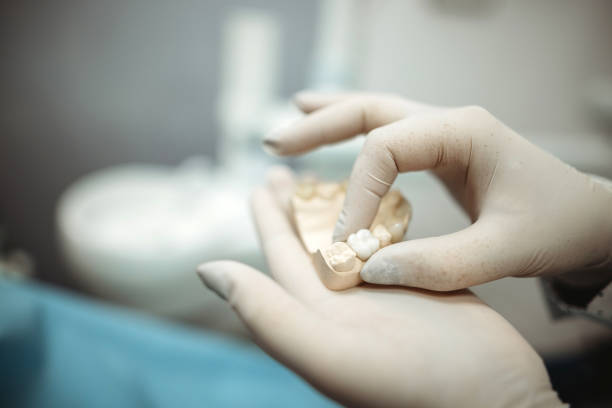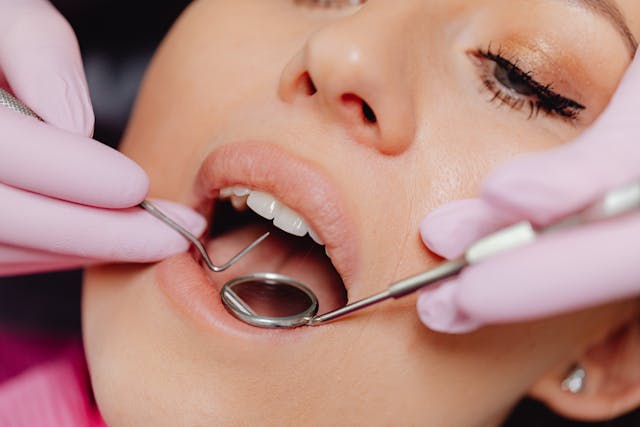Olivia was reading her favorite novel and munching on an apple when she felt sudden pain at the back of her jaw. On visiting the dental clinic, her dentist diagnosed decay on one of her molars. The dentist gave her several options for tooth restorations, each with its own benefits and procedures.
You might have been in the same situation. So, it’s important to know the different types of tooth restoration. Each has a specific procedure. This comprehensive guide will explore the various types of tooth restoration and discuss the process of tooth restoration for each.
What is Tooth Restoration?
Tooth restoration involves repairing or replacing damaged teeth to restore their function and appearance. This dental procedure is used to treat various conditions such as cavities, tooth sensitivity, fractures, old or failed restorations, and cosmetic concerns.

Choosing the Right Procedure for Tooth Restoration
The most suitable types of tooth restoration will depend on several factors. Talking with your dentist is vital to discussing your options and choices. The dentist will assess your oral health and medical history. He/she will then explain to you the benefits and drawbacks of each.
The following factors are considered:
- The extent of damage: The severity will dictate the type of tooth restoration needed.
- Age: The age of the patient may dictate the procedure. For example, some tooth restorations can’t be used on pediatric patients.
- Tooth location: Aesthetic restorations are opted for front teeth. Meanwhile, durable restorations are preferred for back teeth.
- Material strength: Materials like gold and porcelain offer more longevity.
- Cost: Different procedures and materials vary in price.
It is important to discuss your options with the dentist to get the right solution.
What are the Types of Tooth Restoration?

Tooth restoration procedures are tailored to meet individual needs, ensuring both functionality and aesthetics are restored effectively. Here’s a look at the types of tooth restoration:
-
Fillings
Filings are a common form of tooth restoration. They treat cavities caused by dental caries. It can be directly placed in the tooth cavity in one office visit.
The procedure of tooth restoration with fillings involves:
- Treatment planning: The dentist clinically examines the teeth for cavities. An x-ray further confirms the diagnosis.
- Tooth preparation and placement: The decayed tissue is removed. The prepared cavity is filled with material.
- Shaping and polishing: The filling is further shaped and polished for a smooth finish.
The types of filling materials available are:
- Amalgam is a silver-colored filling. It contains mercury mixed with silver and other metals. It is a durable material and has been the gold standard. However, the number of amalgam fillings has decreased over time due to the controversial stance on the presence of mercury.
- Composite resins are tooth-colored fillings that consist of a resin base with powdered quartz. Due to their aesthetic color, composite resins are preferred over amalgam fillings.
- Glass ionomers are tooth-colored materials that are used as cement and sealants.
- Resin-modified glass ionomers are like glass ionomers but more durable.
-
Crowns
Crowns are caps placed over a tooth. They need many office visits.
The process of tooth restoration with crowns:
- Tooth preparation: The tooth is shaped according to the crown.
- Impression and a temporary crown: An impression of the tooth is taken to create a temporary crown, which is later replaced.
- Permanent crown: The permanent crown is cemented in place of the temporary crown.
Types of crowns available:
- Gold crowns are durable and are used for back tooth restorations. The drawback is the color, which makes them aesthetically displeasing.
- All porcelain crowns are made of porcelain. They give your teeth the most natural look. The best option for front tooth restorations is also biocompatible.
- Porcelain fused-to-metal (PFM) crowns combine metal and ceramic, providing the dual benefits of strength and appearance.
- Zirconia crowns are made of zirconium. These crowns are known for their strength and aesthetics.
-
Bridges
Bridges are false teeth that replace missing teeth in your mouth. They consist of a series of crowns attached to natural teeth and require several office visits.
The procedure of tooth restoration with bridges:
- Preparation: The natural teeth are prepared for crowns.
- Impression and bridge: Molds of the teeth are taken. The bridge is custom-made from the mold.
- Placement: The bridge is fitted and checked, followed by cementation.
The type of bridge is determined by the number of missing teeth, the location, and adjacent natural teeth.
The different types of bridges are:
- Traditional
- Cantilever
- Maryland
- Implant-supported
-
Inlays and Onlays
Inlays and onlays are types of tooth restoration. They fall between fillings and crowns. Gold or porcelain is used. Inlays are placed in the cusps of the tooth, and onlays cover one or more cusps.
The procedure of tooth restoration involves removing the decayed tooth tissue. A mold is made of the shaped tooth, followed by a custom-made restoration.
-
Dental Implants
Dental implants are currently the best replacement for natural teeth. It is made of biocompatible titanium.
The process of tooth restoration with implants begins with a surgical procedure. A post is inserted into the jawbone, which functions as the root of the teeth. Later, a crown or bridge is fixed to the post. Implants require multiple appointments over months.
Types of dental implants:
- Endosteal type, in which the post is drilled into the bone.
- Subperiosteal type, in which the post is placed on or above bone.
-
Veneers
Veneers are thin shell-like restorations. Porcelain or composite is used for veneers.
They are mainly used for cosmetic purposes. Veneers are layered on the front surfaces of teeth to improve their appearance.
The procedure of tooth restoration with veneers starts with enamel removal. A small part of the enamel is removed from the tooth surface. Molds of the teeth are taken to create custom temporary veneers. These are followed by permanent ones.
Types of veneers:
- Traditional requires extensive preparation.
- No prep requires less preparation.
-
Bonding
Bonding is a cosmetic procedure. It involves applying a resin material to repair cracked or discolored teeth.
The color of the resin is shade-matched with your natural tooth color.
-
Dentures
Dentures are false teeth used to replace missing teeth. They are used to replace a few teeth or a complete mouth.
Conclusion
Tooth restorations can be chosen for both health and cosmetic needs. It restores the natural function of the teeth or may add a zing to your smile. Your dentist will determine the type of tooth restoration you need.
Restorative Dentistry Services at Hopkins Family Dentistry
The Hopkins Family Dentistry clinic is a community-oriented dental practice focused on your family’s well-being. Experts at the dental clinic provide all types of tooth restorations for your glowing smile. Contact us to discuss your questions and concerns or if you want to set up an appointment!
Our address: 1919 Mainstreet, Hopkins, MN 55343
Phone: 952.935.2121







